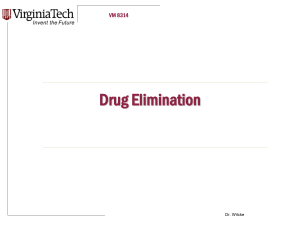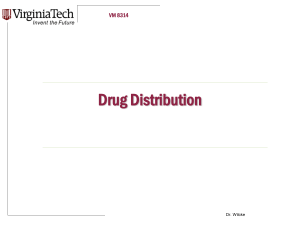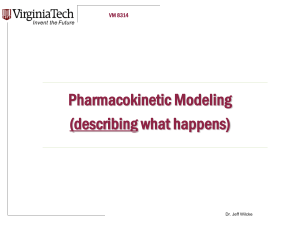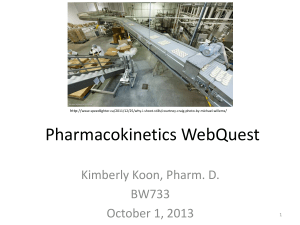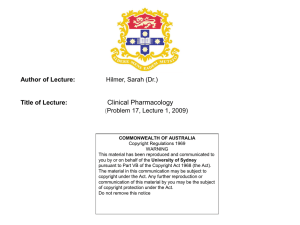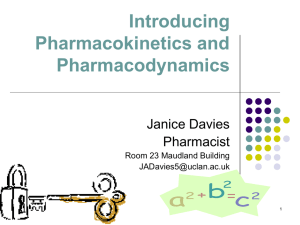VT PowerPoint Template5
advertisement
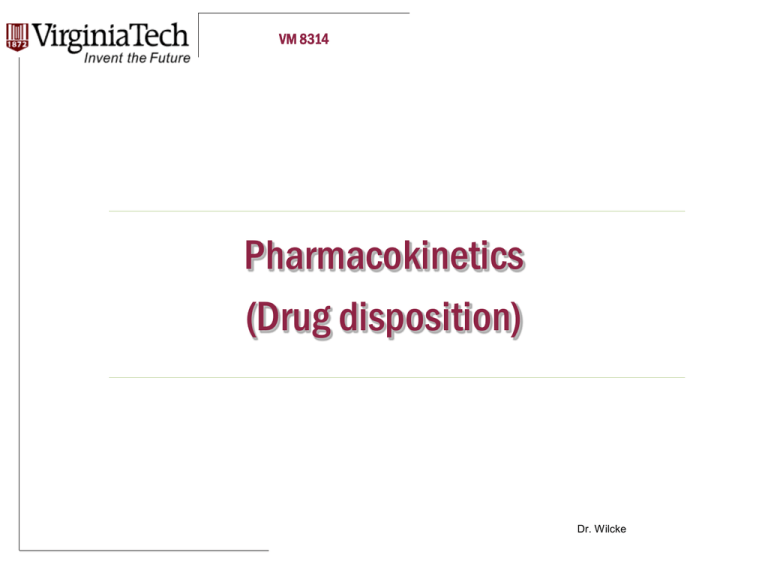
VM 8314 Pharmacokinetics (Drug disposition) Dr. Wilcke VM 8314 Mental picture of what’s really happening inside… Dr. Wilcke VM 8314 General Rules Pharmacokinetics is about processes How things WORK We can only sample from the blood stream. We describe what happens to the MASS (the whole dose) of drug we’ve given. A drug molecule is not in the body until it is in the bloodstream. Dr. Wilcke VM 8314 General Rules Some of this won’t make sense until you see all the parts… Dr. Wilcke VM 8314 General Rules (solubility) 1. Drug must be water soluble to move around. 2. Drug must be lipid soluble to cross barriers. 3. All useful drugs have some solubility in both. Dr. Wilcke VM 8314 General Rules (solubility) Effects are proportional to concentration (at site of action) Concentration at site of action is controlled by concentration in bloodstream. Therefore, concentration in blood stream predicts action. Dr. Wilcke VM 8314 General Rules (solubility) Pharmacokinetics result from interaction of drug chemistry and patient physiology. Species differences affect pharmacokinetics Diseases affect pharmacokinetics Dr. Wilcke VM 8314 Drug Administration Drugs dissolve in body water Drugs enter circulation as water enters circulation Drugs must circulate before they reach sites of action DRUGS ARE NOT IN THE BODY UNTIL THEY ARE IN THE BLOODSTREAM. Dr. Wilcke VM 8314 Oral administration Advantages Cheap, non-sterile, dose forms that control release You CAN recover the dose (if you move quickly) Disadvantages Variability (feeding, physiology, disease) Intractable patients First pass effect Where does the portal circulation go first? Dr. Wilcke VM 8314 Oral administration Table 1. Location of processes Process Primary Location Secondary Location(s) Tablets disintegrate (a suspension forms) Stomach Duodenum for enteric coated forms Drug dissolves from suspension Stomach Duodenum Drug in lipid suspension may be picked up by lacteals (absorption) Duodenum, jejunum, ileum Drug in solution crosses mucosa Duodenum, jejunum (absorption) Stomach, Ileum, colon Dr. Wilcke VM 8314 Oral administration Patient and pharmaceutical factors Pill compression, coatings, suspending agents, etc. GI transit (stomach emptying #1) inflammation, malabsorption Dr. Wilcke VM 8314 Oral administration Regional differences Stomach Lowest absorptive surface Mechanical prep Extreme pH Small Intestine Most absorptive surface Neutral pH Colon rectum Intermediate absorptive surface Neutral pH Dr. Wilcke VM 8314 Intramuscular Administration Advantages More consistent than oral or subcutaneous Certainty of administration Can manipulate to produce a depot Viable for unconscious, vomiting or fractious Almost always the same as IV for efficacy and potency Viable route for emergencies / life-threatening disease Dr. Wilcke VM 8314 Intramuscular Administration Disadvantages More difficult for owners Pain on injection Muscle damage Can’t recover the dose Dr. Wilcke VM 8314 Intramuscular Administration Drug Vehicle Dose Form Water Sol Water Sol Aqueous Solution Water Sol Lipid Sol Suspension Lipid Sol Water Sol Suspension Lipid Sol Lipid Sol Lipid Solution Dr. Wilcke VM 8314 Non-intravenous injection Drug in suspension or lipid solution must dissolve in tissue fluid Drug in aqueous solution only has to mix with tissue fluid Drug DISSOLVED in tissue fluid transits to capillaries. Any of these may be “rate limiting” for absorption. Dr. Wilcke VM 8314 Non-intravenous injection • Aqueous solution: sphere falls apart • Suspensions or lipid solution: sphere holds its shape • If sphere holds its shape, drug must dissolve from the surface into the tissue fluid. • Integrity of the sphere controls absorption. Dr. Wilcke VM 8314 Subcutaneous administration Advantages Less injection pain Owner can be taught to do it. Disadvantages Variability (ambient temperature) Variability (hydration status) Variability (excitement) Variability (location) Dr. Wilcke VM 8314 Subcutaneous administration Variability comes from autonomic control of blood flow Variability comes from physiologic factors. Dr. Wilcke VM 8314 Topical administration Make sure you think about what you’re trying to do! Topical for action on the skin surface Reduced systemic effects Enhanced skin effects Topical for systemic action Easy painless administration Want quick absorption So the drug doesn’t become an oral med So you don’t medicate an affectionate owner Dr. Wilcke VM 8314 Topical administration Disadvanteges Patients groom themselves Toxic skin reactions Blood flow variability Physiology and autonomic control Drug induced effects Dr. Wilcke VM 8314 Topical administration Be cautious about topical formulations from compounding pharmacies Just because it would be NICE to give something topically (and somebody makes something in a topical form), doesn’t mean that it can be made to work. SEE: Hoffman SB, Yoder AR, Trepanier LA. Bioavailability of transdermal methimazole in a pluronic lecithin organogel (PLO) in healthy cats. J Vet Pharmacol Ther. 2002 Jun;25(3):189-93. Dr. Wilcke VM 8314 Topical administration Patient and pharmaceutical factors High lipid solubility and small molecule size favor absorption Skin hydration and abrasion favor absorption Large area of application favors absorption Increased patient and ambient temperature favor absorption. Dr. Wilcke VM 8314 Topical administration Drugs in “like” vehicles stay in the vehicle (e.g., aqueous in aqueous) Drugs in “unlike” vehicles move to the skin surface (e.g., aqueous in lipid) Dr. Wilcke VM 8314 Intraperitoneal Advantage Relatively large absorptive surface Disadvanteges Peritonitis (drugs or needles) Damage to organs Injection into organs Dr. Wilcke VM 8314 Intrathecal Advantages Direct deposit into (onto) CNS Disadvanteges Difficult to calculate dose Toxicity likely (toxicity may be unusual) Infection Dr. Wilcke VM 8314 Intra-articular Advantage High concentration directly to affected tissue Disadvantages Difficult to hit joint space (depends on species) Difficult to calculate dose Joint size? Absorption from joint? Irritate joint surfaces/joint capsule Introduce infection NOT SAME AS “JOINT FLUSH” Dr. Wilcke VM 8314 Regional administration Routes of administration designed to “target tissues” Intra-arterial, Inter-osseous, Intravenous with tourniquet. Produce AND SUSTAIN high blood-to-tissue gradient Many variations on the technique Systemic IV dose with tourniquet Supplement systemic dose with smaller regional dose Systemic dose in bone marrow etc., etc., etc. Dr. Wilcke VM 8314 Regional administration Advantage Probably does increase tissue concentration “some” for “some” period of time Disadvantage Dose calculation is difficult Dosing is still (really) systemic Limited actual efficacy studies Few strong pharmacokinetics studies Dr. Wilcke VM 8314 Regional administration GO GET TRAINING Remain suspicious of the value of this compared to the difficulty and expense (there is little clinical outcome data to support the practice(s). Dr. Wilcke VM 8314 Per rectum administration Advantages Access (unconsious or vomiting patients) Can recover drugs before aborption is complete Disadvantages Drug may not stay where you put it. Basically like oral without mechanical prep of stomach. Dr. Wilcke VM 8314 Intravenous administration No absorption (it’s just “in there”) Bolus Be careful Slow push Most drugs this means 1-2 minutes Some drugs this should be 10-30 minutes Constant rate Drug concentrations rise according to elimination rate Hold stable concentrations for extended periods Dr. Wilcke VM 8314 Intravenous administration Bolus administration Cardiac and respiratory problems Drug and vehicle are in EXTREMELY high concentration in peripheral vein. Dilution begins in vena cava Lung gets high concentrations (pulmonary emboli) Heart muscle gets high concentrations Otherwise and in general: Mixing is very fast Evenly distributed in peripheral blood in 5 – 10 minutes Dr. Wilcke
